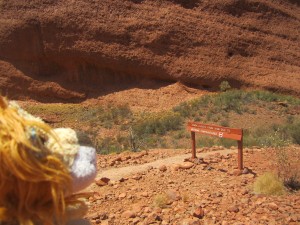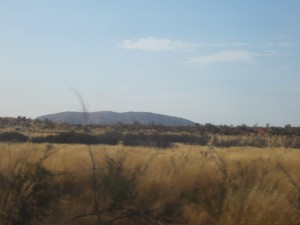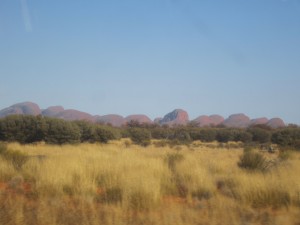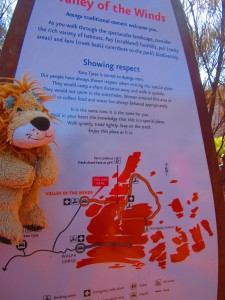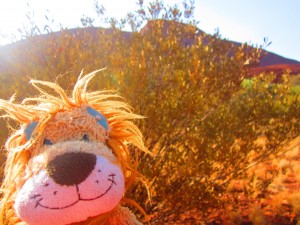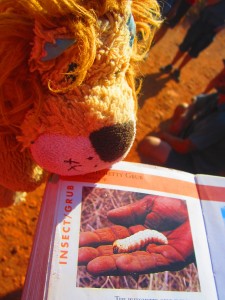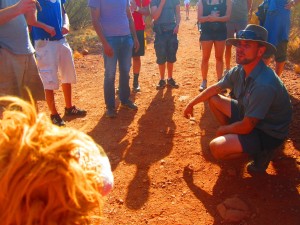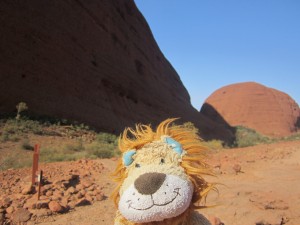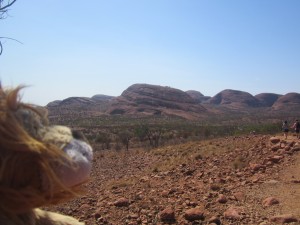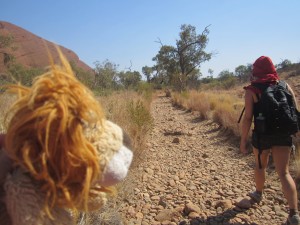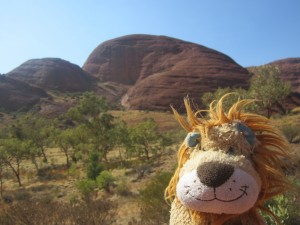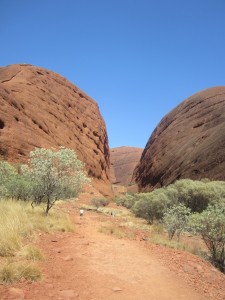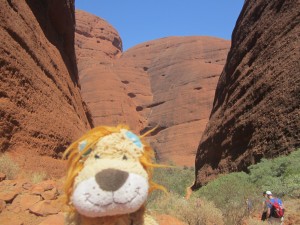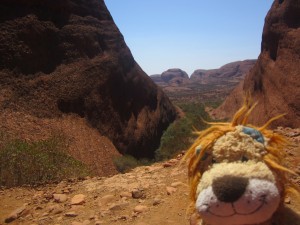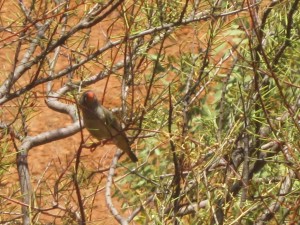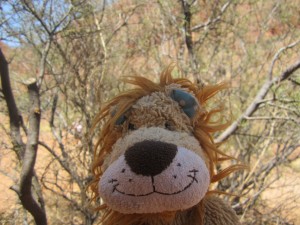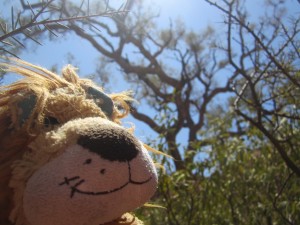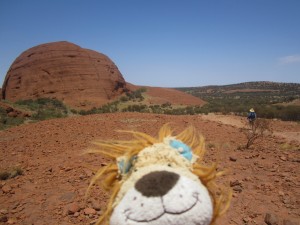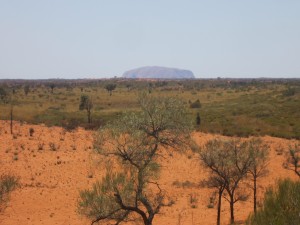Leaving the campsite bright and early that morning was for two reasons: 1) because of the vast distance the group still had to travel to arrive at Kata Tjuta (The Olgas) and 2) because the walk was actually closed after 11 am if the temperature was forecast to rise above 36 degrees centigrade.
The walk which Lewis the Lion and Helen would embark upon, The Valley of the Winds Full Circuit Walk, was one of the more challenging, strenuous walks which would take 4 hours and was a distance of 7.4 km. It was therefore vital that they made an early start and like the day before, took plenty of water with them. Lewis the Lion couldn’t actually believe that he was out walking before 7 o’clock in the morning that day!
Kata Tjuta (The Olgas) lies just 25 km from the famous Uluru (Ayres Rock) and so Lewis the Lion was delighted when from the bus window, he got his first glimpse of Uluru itself. He would get up even closer to it later on that day and learn more about its secrets but for now, he was bound to learn more about the spectacular landform of Kata Tjuta.
Lewis the Lion had never really heard of Kata Tjuta before and when he got there he was surprised that he hadn’t. This site was obviously overshadowed with its close proximity to Uluru but had it been anywhere else in the world, Lewis was sure that it would be a top attraction in itself. Rising from the sand, Kata Tjuta which is the original Aboriginal name for the Olgas meaning ‘many heads’ was a series of 36 rounded peaks. (One of which rises 200 metres higher than Uluru).
Like Uluru, Lewis the Lion discovered that this site too was sacred to its owners, the Anangu people according to Tjukurpa, their traditional law. Whilst everyone is welcomed and encouraged to visit this site, including people they call ‘parampa‘ meaning children or those that lack the wisdom, they request that they respect the area by sticking to the marked tracks.
Along the path, the first place where Camel stopped the walking group was by the Dead Finish Bush. Lewis the Lion had seen many of these bushes scattering the landscape as he journeyed through the Red Centre and he soon learnt of its importance. Deep down, the fat, succulent witchetty grub would bury into its roots feeding off the plant’s sap. The traditional Aborigines would dig down to the roots of the dying part of the plant to find this great source of protein: the witchetty grub. Being in such a harsh, desert environment, the sight of a dying Dead Finish Bush must be a welcome sight to the traditional Aborigines. Furthermore, the Dead Finish Bush is guaranteed to be the last bush standing during even the harshest drought conditions. Not only is it used as a food source but its roots are also used in traditional Aboriginal medicine to bind wounds.
The group didn’t have time today to dig out the witchetty grub so Camel showed them a picture of one instead. If Lewis the Lion was honest, he was rather glad that he missed out on this traditional Aussie tucker but by all accounts, when they are fried a little, these witchetty grubs taste quite buttery!
The walk then took the group alongside these incredible red and orange iridescent domed rocks which each seemed to have its own character.
Camel explained to the group that Ernest Giles was the first European explorer to discovered Kata Tjuta. This unique landform was created over 900 million years ago as it lay in a depression and was in fact a lake in the Amadeus Basin. Over millions of years, sedimentary rock was formed. However 550 million years ago there was an earth movement called a Petermann Orogeny which caused the mountain ranges to rise. Big rocks got deposited first with layer upon layer building up. There were many different types of rock that made up this ‘Conglomerate’ rock including granite, basalt and gneiss as well as minerals such as quartz.
Lewis the Lion thought they were even more spectacular up close as you could see how the various rocks had come together to form these unique domed mountains and they would glisten with the different rock materials.
Padding along however, Lewis the Lion had to be careful of his footing as the ground was uneven with many rocks and pebbles. People had been advised of wearing sturdy footwear and he could see why.
Lewis the Lion was intrigued as to why these rocks stood as 36 individual domed peaks? He discovered that like Uluru it was originally one rock formation but because of the amalgamation of the different rock particles, e.g. the conglomerate rock, it was easy for water to seep through the cracks. Along with the extreme temperatures of day and night, and the wind and the rain, over time the rocks had formed major cracks splitting them up into 36 main mounds. The effect today is that they stand with holes and cracks rather like a steamed pudding which is why it’s sometimes called ‘pudding’ rock.
Under the heat, Helen and Lewis the Lion walked happily along in good company with Amy, Nynke and Stacey. Helen laughed as she said some of the domed rocks reminded her of some of the characters from a 1980s children’s cartoon: The Moomins as it looked as if nature’s elements had carved out faces in the rocks!
Eventually the path rose steeply which left the friends sweaty and breathless as they climbed to the top under a scorching sun.
The view was simply magnificent as you can see in Lewis the Lion’s photo above.
After a long walk, the hikers gathered in the shade in a purpose built shelter whereby Camel told them about how the tribal people used the local environment to their benefit. He told them of bird poo that cures headaches and thorny spikes that get rid of warts, among other things.
He then spoke about some of the different types of gum trees found out in the Outback of which there were over 900 varieties, each with different properties. For instance the Blood Wood Gum or the Desert Blood Gum is traditionally used for tools, water, food and medicine.
There was even a Bush Coconut Tree out here in the Outback.
The steep, rocky and challenging walk was nearly at an end and Lewis the Lion felt that this exercise was a great way to start the morning but was grateful to be returning to the bus to cool down as the sun was pounding down.
They then drove on to an observation point from which they could see both Kata Tjuta and Uluru together. Quite incredible! Lewis the Lion will look forward to telling you more about the world’s biggest rock, Uluru in his next blog.
For all it seemed very early to be up and exercising and taking in this magnificent landscape, Lewis the Lion thoroughly enjoyed himself.
What sporting activity would you be happy to wake up early in the morning to do?

